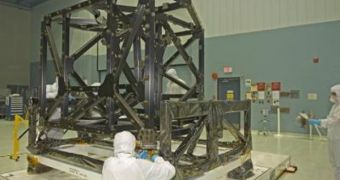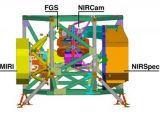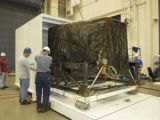The James Webb Space Telescope (JWST) is one of the most ambitious observatories ever planned. Designed to work in infrared wavelengths, it will be a partial successor to the famous Hubble Space Telescope. The JWST, which will be able to see the most distant objects in the Universe with the utmost precision, took another step forward recently, when the Integrated Science Instrument Module (ISIM) structure, the backbone of the telescope, arrived at the Spacecraft Systems Development and Integration Facility, at the NASA Goddard Space Flight Center, in Greenbelt, Maryland.
To understand the importance of the ISIM structure, it is best to compare it to the chassis of a car. It keeps all of the new observatory's four scientific instruments together, and provides the structural integrity needed for the JWST to withstand an Earth departure. It will be the “liaison” between the Mid-Infrared Instrument (MIRI), the Near-Infrared Camera (NIRCam), the Near-Infrared Spectrograph (NIRSpec), and the Fine Guidance Sensor (FGS).
“The ISIM structure is truly a one-of-a-kind item. There is no second ISIM being made,” Goddard ISIM Systems Engineer Ray Lundquist says, and adds that, when completed, the structure will be the size of a small room, and will contain cameras, electronics, harnesses, and other components. The structure was designed at the Center, but was assembled in Magna, Utah, by Alliant Techsystems (ATK). This is the same contractor that was in charge of constructing the DM-1 motor for the ARES I rocket.
The James Webb Space Telescope will follow the tracks of ESA's new Herschel and Planck observatories. It will be inserted into a solar orbit around the Lagrangian point L2. It will orbit some 1.5 million kilometers further away from the Sun than the Earth does, and will be protected from residue light and UV radiation via a single radiation shield. This will allow it to peer as far back in time as possible, possibly to the beginning of the Universe, when the very first structures started populating the newly generated void.
The ISIM Thermal Control Subsystem, the ISIM Control and Data Handling Subsystem, the ISIM Remote Services Unit, the ISIM Flight Software, the ISIM Electronics Compartment, and the ISIM Harness Assemblies are also among the Goddard-designed subsystems that are critical to the normal operation of the telescope's instruments. The JWST is a joint project of NASA, the European Space Agency (ESA) and the Canadian Space Agency (CSA).

 14 DAY TRIAL //
14 DAY TRIAL // 

